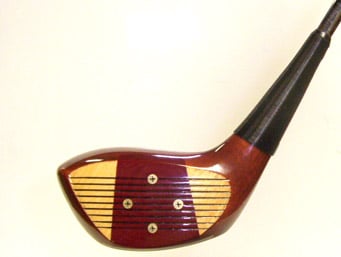Hitting the Ball on the Screws
One of the phrases you may have heard from a TV announcer or veteran golfer who has played for a long time is “It looks like he hit the ball on the screws”. If you are scratching your head trying to figure out its’ meaning, that is simply a way of expressing the fact the player hit the ball extremely well.
 The origins go back to the days when woods were made out of, well…wood. To protect the wood against repeated impacts with the ball, wooden woods were equipped with face inserts made from many different materials. To keep the insert in place, some were were fastened with “screws” which were located in a small area in the center of the face (as pictured). In some cases, a 5th screw could be found right in the center of them all.
The origins go back to the days when woods were made out of, well…wood. To protect the wood against repeated impacts with the ball, wooden woods were equipped with face inserts made from many different materials. To keep the insert in place, some were were fastened with “screws” which were located in a small area in the center of the face (as pictured). In some cases, a 5th screw could be found right in the center of them all.
The screw holes were counter-bored and once the screws were fully tightened the screw heads were sanded so they would fit flush with the face prior to any urethane finish in order not to unduly influence the ball flight. As you can tell, there was a lot of work that went into the creation of a wooden wood.
Golfers who are new to the game in the past 10 or so years have probably never had the experience of hitting a wooden driver or fairway club, just like they haven’t used a steel shaft in a wood or felt the tackiness of a leather-wrapped grip.
It used to be if you miss-hit a wooden driver ½” toward the heel or toe you would lose 7% of your potential distance. Miss-hit 1” toward the heel or toe and you lose a whopping 14% of your potential distance. For example, if you normally hit your driver 230 yards on average, a 14% loss would amount to over 30 yards!
Modern titanium drivers have superior weight distribution and a much higher moment of inertia. To illustrate that, the same 1” off-center shot may end up only penalizing the golfer 5% (11 yards) off of the potential distance. As a result, golf has become less penalizing as you don’t always have to hit the ball “on the screws” or directly behind the sweet spot to get the best results like back in the wooden club days.
Hitting the ball on the screws (or between the screws) is partially based on putting in the quality practice time. The other part comes down to custom fitting your equipment and making sure you have the proper length, grip size, shaft weight and flex to make the most repeatable impact.
